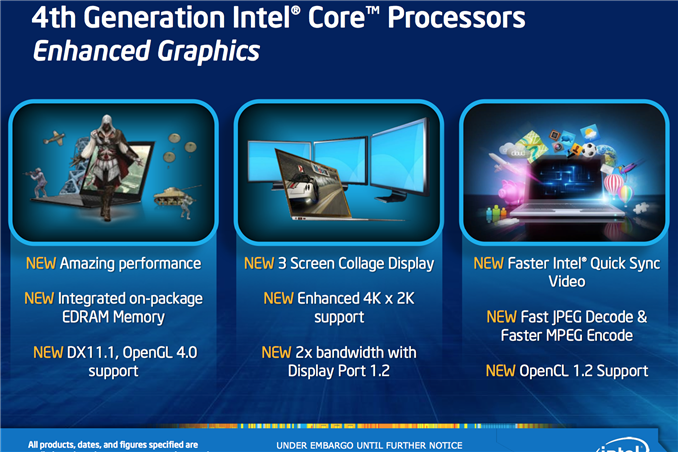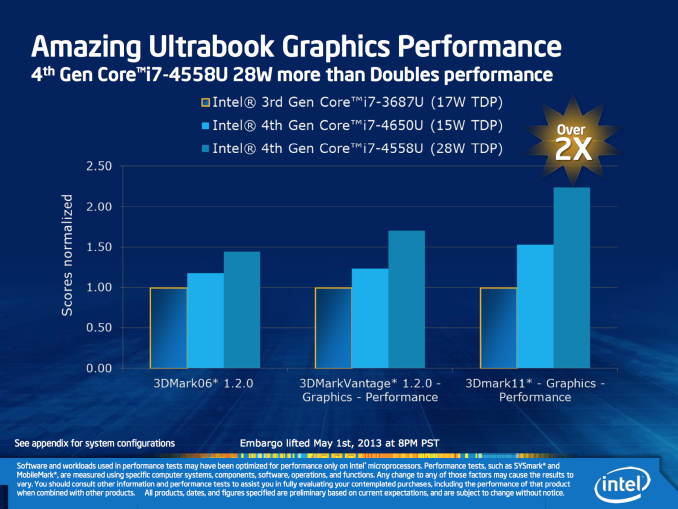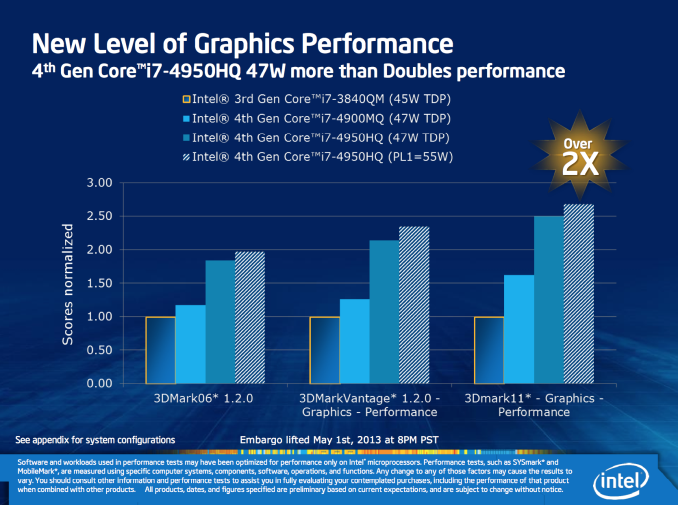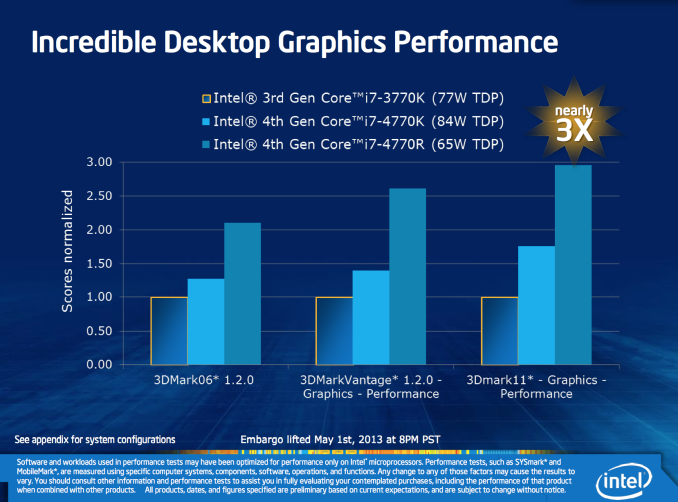Intel Iris & Iris Pro Graphics: Haswell GT3/GT3e Gets a Brand
by Anand Lal Shimpi on May 1, 2013 11:00 PM EST
We’ve known for a while that Intel’s Haswell processor would continue to drive GPU performance in a significant way. With Haswell, Intel will offer a higher end graphics configuration with more execution resources than before (GT3) as well as an even higher end offering that pairs this GPU with 128MB of embedded DRAM on the CPU package (GT3e). Intel’s performance target for the highest end configuration (GT3e) is designed to go up against NVIDIA’s GeForce GT 650M, a performance target it will hit and miss depending on the benchmark.
Regardless of whether or not it wins every benchmark against the GT 650M, the fact that an Intel made GPU can be talked about in the same sentence as a performance mainstream part from NVIDIA is a big step forward. Under no circumstances could Intel compete with NVIDIA on performance and still do so under the Intel HD Graphics brand. Haswell is the beginning of a new era for Intel. The company is no longer a CPU company forced into graphics, but with Haswell Intel begins its life as a GPU company as well. As a GPU company, Intel needs a strong GPU brand. AMD has Radeon, NVIDIA has GeForce, and now Intel has Iris.
The brand is a nod to a long forgotten history of 3D graphics, as well as an obvious reference to the fact that GPUs are used for very visual purposes. Before OpenGL was well, open, it was a project known as IrisGL.
Intel is doing the right thing with Iris and only using it to refer to its absolute best graphics options. Intel HD Graphics will remain, and will refer to all GT1/GT2 and some GT3 configurations with Haswell. Iris and Iris Pro will be used to refer to high end GT3 and GT3e configurations:
Anything with GT3e will have Intel’s Iris Pro 5200 graphics, while 28W SKUs with GT3 will have vanilla Iris 5100 (non-Pro). Any 15W SKUs with GT3 will be HD Graphics 5000, and GT2/GT1 parts will also be identified as Intel HD Graphics.
We know what makes Iris Pro special (128MB of eDRAM), but it appears that the main difference between Iris 5100 and HD 5000 is max GPU clock speed. Intel wants Iris associated with performance, which is a very good thing. Having Iris reach down into non-GT3e parts as well is a bit unsettling but at least GT3e gets the Pro designation.
Intel claims Iris/Iris Pro will deliver up to 2x better performance than Intel’s HD 4000 graphics in notebooks, and it’s using 3DMark11 to validate that claim:
Although Ultrabooks (now 15W) won’t get full blown Iris performance, they should still see a healthy increase in GPU performance compared to where they are today (50% improvement in 3DMark) at a lower TDP. The move to a full speed GT3 part (Iris) should more than double performance in 3DMark. Also worth noting is the fact that we now have a 28W ULT part (i7-4558U). This is a part designed for larger Ultrabooks (14/15"+) that would otherwise have a low end discrete GPU.
Iris Pro will be exclusive to quad-core parts, and the advantage there grows to 2.5x in 3DMark11. There's a slight increase in processor TDP here, but obviously much better performance. That last bar is with the i7-4950HQ running with its TDP set to 55W (cTDP up).
BGA (non-socketed) desktops will also have the option of using Iris Pro if you get an R-series SKU. The performance gains there over Intel HD 4000 are even more impressive thanks to the additional TDP headroom:
QuickSync performance will also improve as a function of increased number of EUs. There’s also DX11.1, OpenCL 1.2, OpenGL 4.0 and 4Kx2K support.
This is really the beginning of a new era. Intel isn't talking specifics about power savings here, but that's really where Iris and Iris Pro will shine. The fact that performance will finally be reasonable enough to actually play games is just icing on the cake. Kicking discrete GPUs out of non-gaming focused notebooks and replacing them with Iris Pro parts should keep performance high while significantly reducing power consumption.
With Iris Intel is finally committed to graphics, and that's a very good thing.















104 Comments
View All Comments
HardwareDufus - Thursday, May 2, 2013 - link
I don't mind the BGA. I haven't upgraded a CPU on a motherboard in years. Still have the same Clarksdale I5-655K on my H55N Gigabyte miniITX machine, still the same 8GB of ram. Still very pleased with the IvyBridge I7-3770K on my P877Deluxe-I Asus miniITX machine, still the same 16GB of ram.I'd have no objection to a Haswell I7-4770KR on a P887Deluxe-I Asus miniITX (it would be nice if Asus released a top of the line miniITX board with the Z87 chipset.. and put the top of the line Haswell with GT3e (Iris Pro or 5200..whatever you want to call it). I'd buy it and wouldn't mind one bit that the CPU was soldered.
Concillian - Thursday, May 2, 2013 - link
Have the Intel drivers gotten any better? This isn't a sarcastic comment, I haven't really looked at Intel drivers since ~Sandy Bridge or so. Drivers were terrible and it wouldn't really matter if the performance was adequate. Have they made inroads on the software front?tipoo - Friday, May 3, 2013 - link
Still very slow updates.Torashin - Thursday, May 2, 2013 - link
If we're going to play that game, the AMD 7660D (5800k GPU) got a score 4.3 times better than the intel HD 4000 on 3Dmark 11. So you can either claim that the Haswell GPU is 2.5 times than Ivy Bridge and still only half as good as Trinity, or it really isn't anywhere near twice as good. Either way, AMD wins.formulav8 - Friday, May 3, 2013 - link
This will be Intels 4th gen or 3rd or something and the earlier 4k series still couldn't beat amds 1st gen iirc. Maybe Intel can claim they beat out AMD's 1st gen fusion or something now?HisDivineOrder - Thursday, May 2, 2013 - link
It won't be long before Iris LE and Iris Lite and IrisL and Iris MX show up to help bring Iris down to the masses with the same old Intel HD graphics of old.Spunjji - Friday, May 3, 2013 - link
That is, indeed, Intel's usual style.Jumangi - Thursday, May 2, 2013 - link
Until Intel commits to vastly improving their pathetic driver support this announcement doesn't mean squat to me. AMD and Nvidia know that great graphics has 2 parts to it. So far Intel choses to ignore one of them.Frenetic Pony - Thursday, May 2, 2013 - link
Both impressive and disappointing, nice improvement but I'm vastly disappointed in how restrictive the TDP and chip levels are. I'd love to see a 5200 or 5100 in a much lower TDP set. If a Haswell CPU can get down to a 10 watt TDP for a core i5 I don't think an underclocked 5200 in a 17 watt TDP would be too much to ask.Basically, a Core i5 is all I need for CPU power. My current Ivy Bridge Core i5 is as fast as I need, for games or lightroom or etc. The GPU on the other hand still struggles with anything beyond the most basic games. If Intel won't do it I have hope Nvidia will. I'd love to see a dedicated Nvidia mobile card fit into a 10 watt core i5 and a 13" ultrabook, whatever that would require.
l_d_allan - Friday, May 3, 2013 - link
Literally a "war story" ... I worked on a project in the 80's on Silicon Graphics ** Iris ** workstations doing Star Wars simulations. Smart pebbles and brilliant rocks. Hypercube supercomputer back-end. Bleeding edge.